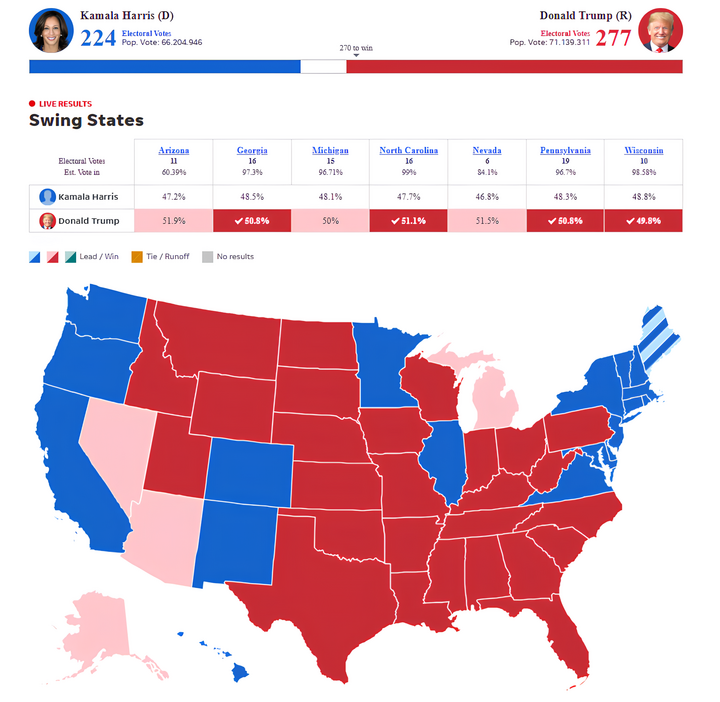With more than 277 electoral votes, exceeding the minimum majority (270 votes) to win, Mr. Donald Trump is almost certain to become the next President of the United States.
Notably, Mr. Trump won in the battleground states of Georgia, North Carolina, Pennsylvania and Wisconsin, while dominating the remaining three battleground states of Arizona, Michigan and Nevada.

Mr. Donald Trump is predicted to win in all 7 battleground states. (Source: USA Today)
Battleground states play a decisive role in US elections. These states are roughly evenly split between Democrats and Republicans, and the election outcome is often decided here. This year, the battleground states include Pennsylvania, with 19 electoral votes, Michigan (10), Georgia (16), Wisconsin (10), North Carolina (16), Nevada (6) and Arizona (11).
If Mr Trump wins all seven battleground states, it would be a huge reversal, as Democrats won six in the last election. Such a result would also mean a clear endorsement of the Republicans and a complete rejection of the Democrats.
Voting situation in battleground states
Pennsylvania: Mr. Trump won this important state back from the Democrats this year, winning 50.8% of the popular vote.
Pennsylvania's electorate is a mix of urban, suburban and rural voters with a wide range of political views. Winning Pennsylvania was crucial to Joe Biden's victory in the 2020 US presidential election.
North Carolina: This battleground state also saw a tight race between Mr. Trump and Ms. Harris. Mr. Trump won 51.1% of the popular vote, Ms. Harris followed with 47.7%.
North Carolina has seen an influx of young professionals in the technology and finance fields, resulting in a more diverse population.
Georgia: A traditionally Republican stronghold, Trump won the state from the Democrats with 50.8% of the vote, compared to Harris's 48.5%. The state is known for its well-developed and diverse population, with a significant increase in minority and young voters.
Nevada: Mr. Trump turned this battleground state “red,” ending decades of Democratic dominance. He led in Nevada with 51.5% of the vote compared to Harris’s 46.8%.
This western US state has a large Hispanic population, a growing Asian-American community and a strong labor union presence. These groups tend to lean Democratic but are considered politically diverse.
Arizona: Mr. Trump is dominating the Mexican border state, which has been plagued by immigration crises, with 51.9% of the vote. Harris trails behind with 47.2%. After strongly supporting Republican candidates from 2000 to 2016, the state flipped to support Mr. Biden in 2020.
Wisconsin: Trump won this rust belt state with 49.8% of the popular vote. Harris came in a close second with 48.8%. Wisconsin flipped to Trump in 2016 and then to Biden in 2020, by a narrow margin in both elections. Trump’s promise to bring manufacturing back to the US resonated in a state that has suffered from industrial decline in recent decades.
Michigan: Mr. Trump leads in this traditionally Democratic stronghold with 50.1% of the vote. Ms. Harris trails behind with 47.2%. Once part of the Democratic “blue stronghold,” Michigan swung to Mr. Trump in 2016, then back to Mr. Biden in 2020. Michigan has also been hurt by the loss of manufacturing jobs and liberalized global trade policies.
Source: https://vtcnews.vn/du-doan-ong-trump-gianh-phieu-o-ca-7-bang-chien-dia-ar905950.html
































![[Photo] "Beauties" participate in the parade rehearsal at Bien Hoa airport](https://vstatic.vietnam.vn/vietnam/resource/IMAGE/2025/4/11/155502af3384431e918de0e2e585d13a)






























































Comment (0)